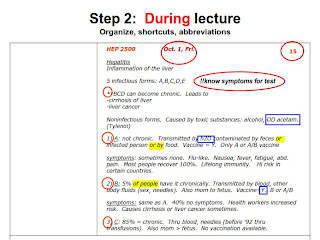Here is the rest of the Cornell Notes process. The most important thing for students to remember is to make their questions in the left hand column after they take notes during class on the right. Students should also mark up their notes after taking them by highlighting, underlining and circling headings and key words. Summaries should be a paragraph of complete sentences. Cornell Notes need to be taught and reviewed for students to learn the process and refine it. Teachers should see improvement in the quality of questions students create, summaries and remembering to highlight, etc... I had students test themselves by covering the notes section so they could only see the questions they have created. A partner can hold the notes and ask the questions, as well.
Here's an excellent video about Cornell Notes, as well. http://www.youtube.com/watch?v=Suhc7AX97a8&feature=related








I teach this method to my eighth grade Social Studies classes too. I agree that it takes awhile for them to practise and master each aspect of it, especially writing good questions, which requires a few practice activities.
ReplyDeleteThough in later units of the year, I ended up relying more on fill-in-the-blank notes to save time, since writing notes by hand took much longer and it was sometimes debatable whether it was helpful or whether time was better spent using and applying the notes in other activities. I tried to include a column on the left for writing questions from these fill in the blank notes, but there was often not enough room on the page, unfortunately.
At the middle school level (which 8th grade is here) that is probably fine. At the high school level, we are trying to get students to be more independent and self-directed. It's important for students to recognize what info is important enough to be included in their notes and to create a system of abbreviations that they will understand when they review their notes later. Students will need to be able to take effective notes even when an instructor speaks quickly in A.P. classes and in college. They won't be using fill in notes and often don't even point out what should be included in students' notes. That's why AVID students are required to take notes in every core subject, regardless if the teacher tells them to or not. I might do fill-in-the-blank notes with freshmen (9th grade) but after that, I would transition into notes they create themselves. If there isn't enough room on a page for the left hand question column you can have students staple or tape extra paper to the side for their questions. It doesn't look pretty but it works!
ReplyDeleteAccording to some grads, nowadays, with Powerpoint, a lot of instructors even in college or university are just printing the notes out for students (and they add supplementary notes on the side). I know in senior science classes, a lot of teachers aren't really doing the old school note-taking any more, just because of the huge amount of content that is covered. Unless students are mostly learning out of the textbook themselves and taking notes from that, in which case this format is also very useful, especially your point about recognizing what info is important.
ReplyDeleteRegardless, I still teach this since I think it's important to introduce students to a variety of notetaking and study techniques. And even with Powerpoint notes printed out, students should write questions for themselves for study purposes. It's just messier than the 2 column style.
That's a good idea to staple an extra paper for questions though it's just awkward for two sides. I always tell them it's a great study method to look at the question, and cover the answers, see if they can answer it, and then it's so handy to have the "answers" right beside. Finding class time to do this is another practical challenge I had, since when assigned for homework, some students didn't do it, or did a bad job.
The other thing I've noticed is it's important for students to space out their notes, so there is room to write the question on the left beside. More often than not, the notes are squished, single-spaced.
Great blog posts on this topic. It's nice to see it so clearly laid out.
Thanks! I know there are some college instructors who are getting fed up with students coming to them without the skills they expect students to have. Some end up trying to make things easier by lowering their expectations. I want my students to be successful at any 4 year college of university though. If they go to a UC campus, which many do, professors will not give them shortcuts on notes. And like you said, if students just take the hand-out notes and don't work with them in a meaningful way, they won't help them anyway. Summarizing and creating questions from hand-outs is an effective study strategy when you do not have notes. Another good study strategy to compliment notetaking is flashcards. I'll do a post about that in the future.
ReplyDelete